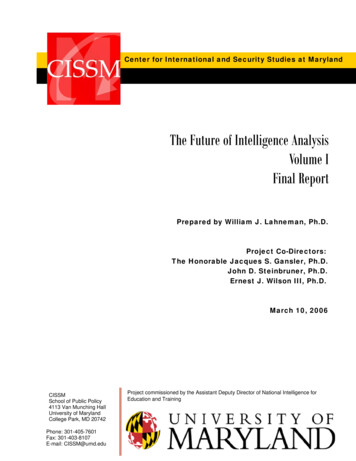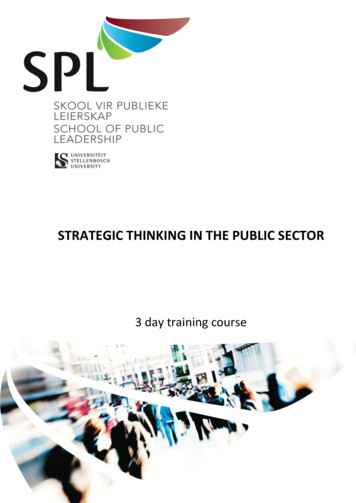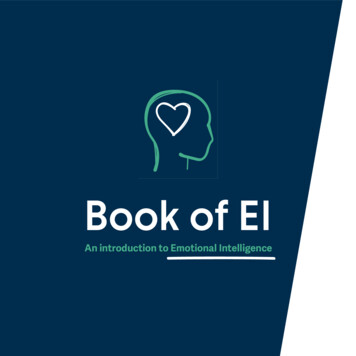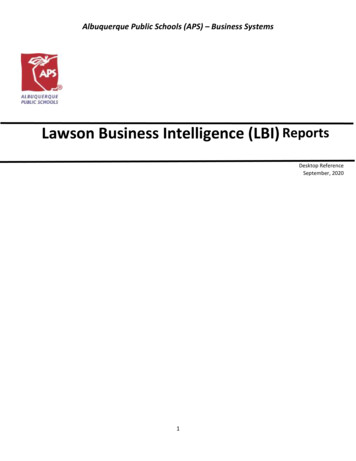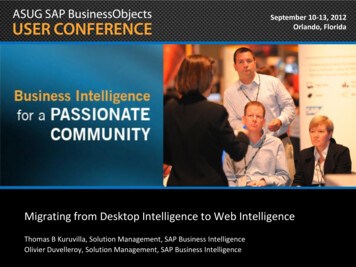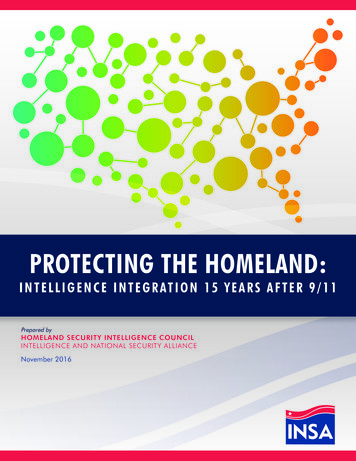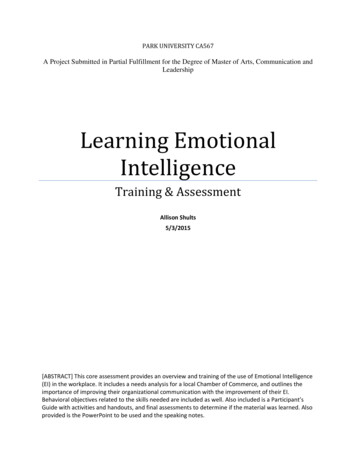
Transcription
INTRODUCTION TOSTRATEGIC INTELLIGENCEGIA WHITE PAPER 2/2004
Executive SummaryStrategic intelligence (SI) is an important tool ininforming and supporting strategic managementactivities in different stages of the strategydevelopment. In short, Strategic Intelligence canbe defined as “a systematic and continuous processof producing needed intelligence of strategic value inan actionable form to facilitate long-term decisionmaking”. Customers of SI include individualsinvolved in strategic decision-making.From the process perspective, Strategic Intelligencecan be seen as a part of Competitive Intelligence,as it is also a systematic and continuous processwith a purpose to facilitate decision-making withneeded and timely intelligence input delivered inactionable form. The major difference between SIand CI is that SI actions focus strictly on supportingstrategic decision-making by monitoring aspectswith strategic significance. Additionally, a SI timehorizon is broad and the focus is on all significantevents: past, present and future events.In order to practice effective Strategic Intelligencecapable of meeting the needs of strategicmanagement and introducing intelligence ofstrategic value into the decision-making process,certain critical aspects should be considered. Theyinclude: Appointing a strategic level process owner,preferably the VP for Corporate Strategy, and aseasoned SI Manager. It enables integrating thebest available internal senior expertise into theSI process. Knowing and understanding the internal SIcustomers - individuals involved in strategicplanning. Defining the SI priorities and properlycommunicating them (critical strategic themes,key players to be analyzed, early warningthemes). Designing and producing SI products that servecustomers’ content needs and communicationneeds. Building a network of Strategic Intelligencecontributors, both internal and external.GIA White Paper 2/2004 Introduction to Strategic Intelligence
1. IntroductionThis paper focuses on the relationship betweenStrategic Intelligence and strategy. The aim isto provide readers with a definition of StrategicIntelligence (SI) and explain the role of intelligencein formulating and implementing strategy.monitor, interpret, and respond to environmentalchanges. This is where SI, a systematic processof collecting, analyzing and communicatingactionable strategy-oriented business information,can serve as input in strategic decision-making.The role of Intelligence in strategy formulation isa critical one, especially now, given the quicklychanging business environment. As the paceaccelerates, it becomes more difficult for seniormanagers and decision-makers to adequatelyThe paper begins with a discussion on strategyand attempts to define for readers the concept ofStrategic Intelligence (SI). Strategic Intelligenceas a part of Strategy Development will then bediscussed followed by some concluding remarks.2. StrategyThe concept of strategy has been around for aslong as there have been organizations and wars.Inevitably, there has been a huge amount ofstudies and writings on the subject. Today, thereare different ways of defining strategy and theconcept of strategy can be viewed from manyangles. The aim of this chapter is not to providea clear-cut definition of strategy but to givereaders an overview of strategy which can serve asa framework for studying the relationship betweenStrategic Intelligence, strategy formulation andimplementation.As mentioned earlier the concept of strategy canbe viewed from different angles. Here are some,but by no means all, dimensions that should beincluded in any unified definition of the conceptof strategy. These dimensions can provide aninsight on how thinking strategically can benefitour business.Some traditional views: Strategy as a coherent, unifying and integrativepattern for decision- making, a blueprint forthe whole organization that indicates theorganization’s future destination. Strategy as a means of establishing anorganization’s purpose in terms of its longterm objectives, action plans and priorities forresource allocation; aligning short term actionand resource deployment to be congruent withlonger term objectives. Strategy as a definition of a firm’s competitivedomain including defining the businesses a firmis in or intends to be in, segmentation, strategicpositioning and how and where it is going tocompete. Strategy as a response to external opportunitiesand threats and to internal strengths andweaknesses; a means of achieving a longrange competitive advantage, and a favorablecompetitive position and adapting to meet thedemands of a changing environment. Strategy as a logical system for differentiatingmanagerial tasks at the corporate, businessand functional levels; defining an overallmission and allocating resources with a senseof strategic priorities. Strategy as a definition of the economic andnon-economic contribution the firm intends tomake to its stakeholders.GIA White Paper 2/2004 Introduction to Strategic Intelligence
From the unifying point of view, strategy becomesa fundamental framework through which anorganization can assert its vital continuity whileat the same time purposefully managing itsadaptation to the changing environment to gaincompetitive advantage.Having a “strategic thinking” mindset does not, initself, always generate a fully functional strategyfor an organization. On the other hand,Strategic planning does notguarantee strategic thinking.Most strategic planning systemsrely on historical data andnumbers generated internally.These systems often require long and exhaustiveanalysis. The result is an extrapolation of historyinto the future. Strategic thinking, on the otherhand, incorporates an assessment of both theinternal and external environment. The processinvolves a qualitative evaluation of the businessand its environment and is both introspective andextraspective.When discussing strategic planning, strategicdesign or strategic thinking, it is important to giveconsideration as well to strategic management.Michael Porter’s statement “The essence ing competitive strategy is relating acompany to its environment” highlights severalkey dimensions of strategic management.1. The first part of the statement, “the essenceof formulating”, indicates that there mustbe a process at play. Whether structured orunstructured, formal or informal, rational orirrational, the organization must proceedthrough a number of steps before it can arriveat a strategy. This dimension of strategicmanagement, which looks at the how ofstrategy, is referred to as the strategy process.2. The next part of the statement, “competitivestrategy”, indicates that the strategy processmust result in a strategic outcome. This outputof the strategy process is a course of action tobe followed by the company that will allow forthe fulfillment of the company’s objectives inthe face of competitive pressure. This dimensionof strategic management, which looks at thewhat of strategy, is referred to as strategycontent.3. The final part of the statement, “is relatinga company to its environment”, indicatesthat strategies are developed to suit varyingorganizational and environmental contexts. Thisdimension of strategic management is referredto as strategy context and looks at where, when,who, and why.StrategyImplementationEvaluationand ControlFigure 1. Four basic elements of strategic managementLet’s now have a look at the basic elements ofstrategic management – elements which attemptto provide insight into the strategy process (how),strategy content (what) and strategy context(where, when, who and why):Environmental scanning includes both externaland internal scanning. The external environmentconsists of the task environment and the societalenvironment. The task environment (also referredto as industry) includes competitors, customers,suppliers, interest groups etc. The societalenvironment includes more general forces suchas technological and political-legal forces. Theinternal environment includes the corporation’sstructure, culture and resources.Strategy formulation includes the corporatemission/vision, objectives, strategies andpolicies.Strategy implementation is a process by whichstrategies and policies are put into action (e.g.programs, budgets and procedures).Evaluation and control: corporate activitiesand performance results are monitored so thatactual performance can be compared with desiredperformance.GIA White Paper 2/2004 Introduction to Strategic Intelligence
3. Definition and Tasks of Strategic IntelligenceCompetitive Intelligence (CI) is often defined asknowledge and foreknowledge about the externaloperating environment of the organization. Thepurpose of CI is to facilitate proactive decisionmaking by producing the needed businessinformation into actionable form and making itavailable at the right time. The orientation andutilization of CI is tactical and to some extentstrategic. The CI time horizon focuses on presentevents and, to some extent, on past and futureevents as well. Some CI processes are designedto serve the strategic level, while some focus onoperative monitoring or both.needed and timely intelligence input delivered inactionable form.The major difference betweenSI and CI is that SI actionsfocus strictly on supportingstrategic decision-making bymonitoring aspects with strategicsignificance.Strategic Intelligence is a type of CompetitiveIntelligence produced for strategic purposes.Customers of SI include individuals involved instrategic decision-making.Users of SI are primarily individuals involvedin strategy development. Additionally, a SItime horizon is broad and the focus is on allsignificant events: past, present and future events(Figure 2). In short, Strategic Intelligence canbe defined as:From the process perspective, Strategic Intelligencecan be seen as a part of Competitive Intelligenceas it is also a systematic and continuous processwith a purpose to facilitate decision-making with“A systematic and continuous process of producingneeded intelligence of strategic value in anactionable form to facilitate long-term evelStrategic IntelligenceCompetitive tPresentFutureFigure 2. The Scope of Strategic Intelligence. Source: McGonagle & Vella, 1996GIA White Paper 2/2004 Introduction to Strategic Intelligence
Strategic Intelligence has to be highly needbased. Here, need refers to content needs as wellas communication needs of the content (format,timeliness etc.). Typically, the higher the strategicanalysis level, the more interactive the intelligencecommunication and the less information quantityare required. Some typical, content relatedstrategic intelligence needs include: Impact-analysis/so-what analysis: how doesa certain phenomenon affect the company’sbusiness Business driver analysis: what are the main drivingforces affecting the business environment Scenarios with probable outcomes/long rangeviews of battlefield developments In-depth competitor and key-customer analysesinstead of company profiles Bird’s eye view of the business environment:overall battlefield illustrations Relevant macro issue and trend analysis andtheir impact Analysis of critical strategic themes3.1. Strategic Intelligence as a part of Strategy DevelopmentWhat are the roles of SI activity in strategic decisionmaking? Six basic roles can be identified:1. Describing the competitive environment:Intelligence analysis must define the currentcompetitive arena in which the company operates.BusinessEnvironmentAn intelligence assessment must be made of theforces and factors that make up the company’scompetitive environment. The figure 3 belowshows a generic model of a strategic businessenvironment/competitive environment.General paniesInterest GroupsMarketRegionSuppliersValue Chain DimensionFigure 3. Strategic Business EnvironmentGIA White Paper 2/2004 Introduction to Strategic Intelligence
2. Anticipating the future of the competitiveenvironment: The intelligence departmentshould be able to provide forecasts regarding thecompetitive environment in which the companyis likely to find itself in the future.The future is about change: some of the future ispredictable, most of it not.Scenario planning should be usedas a means of supporting strategicplanning by identifying emergingcompetition, technologies andcustomer needs well in advancein order to formulate a predictionthat can initiate an early change ofdirection.The voluminous body of literature on themanagement of change explicitly proposesthat strategic intelligence is a pre-requisite forchange.3. Challenging the underlying assumptions asking the right questions: A very importantrole for intelligence is identifying and challengingunderlying assumptions held by management(economic, political, technology-related, as wellas market and customer related) which may impactstrategic thinking.4. Identifying and evaluating companyweaknesses against market opportunities andthreats: Intelligence can be used to identifyand assess a company’s own weaknesses andvulnerabilities; a process often reserved forcompetitors.5. Using intelligence to implement andadjust strategy to the changing competitiveenvironment: Once a company’s strategy has beenformulated, it will go through two distinct phasesof implementation. The first phase is during itsinitial implementation, when competitors begin tosense and react to the strategy’s salient features.Good intelligence on how the competitor isresponding and adjusting to the strategy’s initialimplementation is very valuable, both to test itseffectiveness and to begin making adjustmentsthat compensate for any countermeasures thecompetition is likely to initiate.6. Determining when the strategy is no longersustainable: Once a successful strategy has beenput in place and it has survived the initial phasesof implementation, it is important that an ongoingreporting and collection program be establishedto monitor the competitors’ actions.All these SI roles inform and support strategicmanagement activities in different stages of thestrategy development. During environmentalscanning SI has a pivotal role in assessingthe competitive environment. During strategyformulation SI assists decision-making by makingforecasts about the competitive environmentand by challenging underlying assumptions- asking the right questions and identifyingand compensating for exposed weaknesses. SIsupports strategy management activities duringstrategy implementation by using intelligence toimplement and adjust the strategy to the changingcompetitive environment. During evaluation andcontrol of the actual strategy, the role of SI isto determine when the strategy is no longersustainable and to support any counterintelligenceactivities/changes required.3.2. Critical Strategic ThemesAn important aspect in strategic development andin the nature of required SI is critical strategicthemes (CST). Critical strategic themes have a majorimpact on the strategic business environment andthe change therein.“Moves and changes which arenot observed cannot be reactedto”. SI plays an important rolein controlling these moves andchanges.Critical strategic themes should be based on acompany’s strategy, mission and vision statements.Every organization should be able to identify thosethemes that require monitoring and analysis sothat the company retains its competitiveness andimproves its position in the marketplace.Typically, a strategic theme covers a wide rangeof issues to be analyzed. An example of sucha theme would be long-term changes in thedistribution logic due to the development ofelectronic channels. Industry consolidation isGIA White Paper 2/2004 Introduction to Strategic Intelligence
yet another generic strategic theme for manycompanies. In particular, companies in traditionalindustrial sectors need to go beyond typicalcustomer information and dig into the valuechain more thoroughly to analyze their customers’customers and their respective industries in orderto understand the real drivers of their business.GlobalizationBusinessEnvironmentSome generic themes are presented in Figure 4below. Critical strategic themes will differ for eachcompany, depending on the business environmentthey are in.General TrendsEnvironmental uppliersCompetitorsCustomersNew needsConsolidationChanges in value chainsInterest GroupsNew standars & legislationionCompaniesNew applicationsRegPrice ryrkSupplierIndustriesMaIndustriesValue Chain DimensionFigure 4. Examples of Critical Strategic ThemesGIA White Paper 2/2004 Introduction to Strategic Intelligence
4. ConclusionIn order to practice effective Strategic Intelligence(SI) able to meet the needs of strategic managementand introduce intelligence of strategic value intothe decision-making process, certain criticalaspects should be considered. Appointing a strategic level process owner,preferably the VP for Corporate Strategy, anda seasoned SI Manager enables integratingthe best available internal senior expertiseinto the SI process. The SI Manager shouldbe equipped with in-depth understanding ofthe battlefield and be respected as an expertin the organization’s business and markets.He/she should also participate in the strategyprocess. Knowing and understanding the internalcustomers. SI customers are individuals involvedin strategic planning. Defining the SI priorities and properlycommunicating them (critical strategic themes,key players to be analyzed, early warningthemes). It is important that the criticalstrategic themes be clearly communicated toeveryone who is expected to contribute inputto strategic analysis. Designing and producing SI products thatserve the customers’ content needs andcommunication needs. Here, “products” referto highly interactive management briefings andvisual actionable intelligence information packsas opposed to massive static reports. Building a network of Strategic Intelligencecontributors, both internal and external.In the future, building SI capability together witheffective scenario planning will become more andmore important especially when restructuring thetraditional strategy processes to meet the needs ofconstantly changing business environments.When discussing the roles of SI in strategydevelopment and the relationship between SIactivities and the company’s strategy, SI couldbe described as a sonar, searching for underlyingopportunities and threats that cannot easily beobserved (monitoring critical strategic themes)and a radar helping the company on its roadto the future, supplying intelligence aboutturning points (promoting a change in direction,forecasting what is ahead, developing scenarios)for the enterprise.GIA White Paper 2/2004 Introduction to Strategic Intelligence
The GIA White Paper series1/2004 Introduction to Competitive Intelligence2/2004 Introduction to Strategic IntelligenceAbout the GIAThe Global Intelligence Alliance (GIA) is a global network of business research and CompetitiveIntelligence (CI) consulting companies. Leveraging its worldwide reach, the Global Intelligence Allianceprovides multinational organizations with a single source for all CI requirements including: processconsulting, intelligence services, education, and leading technology solutions.For further information or assistance in any Competitive Intelligence-related matters, please contact theGIA Member company closest to You, or refer to the GIA website at www.globalintelligence.com.GIA White Paper 2/2004 Introduction to Strategic Intelligence
Global Intelligence AllianceFor more information, please visit www.globalintelligence.com or contact the GIA representative closest to you:InternationalGlobal Intelligence Alliance GroupAustraliaGlobal Intelligence Alliance AustralasiaLevel 12, 95 Pitt Street, Sydney, NSW 2000, AustraliaBrazilGlobal Intelligence Alliance Latin AmericaRua Joaquim Floriano, 466 cj 306 – Itaim Bibi CEP: 04534-002 – São Paulo, SP, BrazilCanadaGlobal Intelligence Alliance Canada174 Spadina Avenue, Suite 302, Toronto, Ontario, M5T 2C2, Canada 1-416-231-0828canada@globalintelligence.comCentral & Eastern EuropeGatewayBalticElizabetes 51, 1010 Riga, Latvia lobal Intelligence Alliance ChinaUnit 2602, United Power International Plaza, 1158 Jiangning Road, Shanghai, 200060, P.R. ChinaFinlandGlobal Intelligence Alliance FinlandItämerenkatu 1, 00180 Helsinki, Finland ceRV Conseil48, rue des Moines - 75017 Paris, France 33-1-42 29 56 72france@globalintelligence.comGermanyGlobal Intelligence Alliance Germany GmbHDorotheenstraße 1, 45130 Essen, GermanyHong KongGlobal Intelligence Alliance Hong Kong31/F, Tower One, Times Square, 1 Matheson Street, Causeway Bay, Hong KongJapanMcRBCNogizaka Lilien Heim 601, 1-26-16, Minami-Aoyama, Minato-ku, Tokyo 107-0062 Japan 81-3-5771-7120japan@globalintelligence.comSouth Korea3mecca6th F. Kyungjae Tongshin Bldg, 111 Junghak-dong, Jongno-gu, Seoul, Korea 110-150 Americas Market Intelligence (Mexico)Pestalozzi 923, Col. Del Valle Mexico, D.F. 03100 MexicoPortugalGrowth SettingAvenida Engenheiro Duarte Pacheco, Amoreiras, Torre 2, Piso 5, sala 9, 1070-102 Lisboa, PortugalRussiaALT Research & Consulting105122, Tschelkovskoe shosse, 2, bld.1, Moscow, RussiaSingaporeGlobal Intelligence Alliance Singapore8 Eu Tong Sen Street, #23-81 The Central, Singapore 059818South AfricaButterfly Effect IntelligenceNorth Block, Sheldon Place Office Park, 5 Lone Close, Lonehill, South AfricaTunisiaRV Conseil Tunisie11, avenue 02 mars, Manouba, TunisiaUKGlobal Intelligence Alliance UK55 Old Broad Street, London EC2M 1RX, United KingdomUSA East CoastGlobal Intelligence Alliance USA Inc.1 Penn Plaza, 36th floor, New York, NY 10119, USAUSA FloridaAmericas Market Intelligence166 Alhambra Circle, Suite 200, Coral Gables, FL 33134, USAUSA MidwestGlobal Intelligence Alliance USA Inc.8770 West Bryn Mawr Avenue, Suite 1300, Chicago, IL 60631, USA 358-(0)10-613-2000info@globalintelligence.com 61-2-8249-8363australasia@globalintelligence.com 55-11-2165-6810brazil@globalintelligence.com 86-21-6279 0197china@globalintelligence.com 49-201-266-900germany@globalintelligence.com 852-2824-8511hongkong@globalintelligence.com 52-1-55-4345 8110mexico@globalintelligence.com 351-210-480 674portugal@globalintelligence.com 7-495-788 59 29russia@globalintelligence.com 65-6423-1681singapore@globalintelligence.com 27-11-465-9711southafrica@globalintelligence.com 33-1-42-29-56-72tunisia@globalintelligence.com 44-207-997-6320uk@globalintelligence.com 1-212-786-7368usaeast@globalintelligence.com 1-305-458-2493usaflorida@globalintelligence.com 1-773-867-8352usamidwest@globalintelligence.com 2014 Global Intelligence Alliance. All rights reserved.
guarantee strategic thinking. Most strategic planning systems rely on historical data and numbers generated internally. These systems often require long and exhaustive analysis. The result is an extrapolation of history into the future. Strategic thinking, on the other hand, incorporates an assessment of both the internal and external environment.

